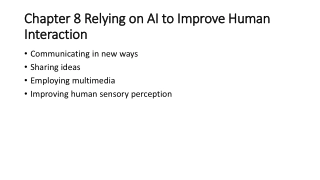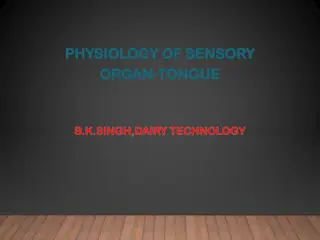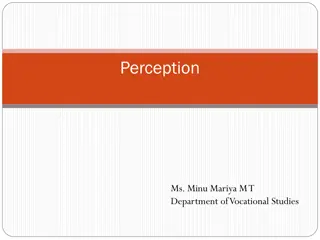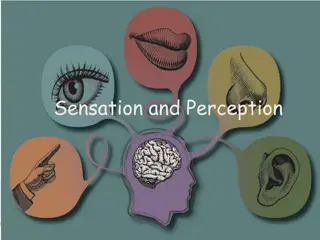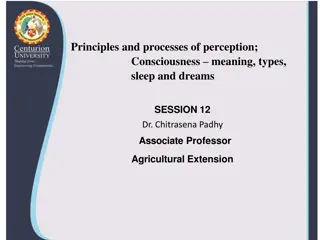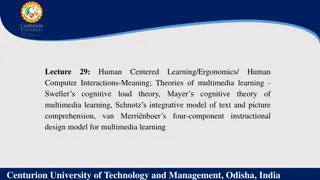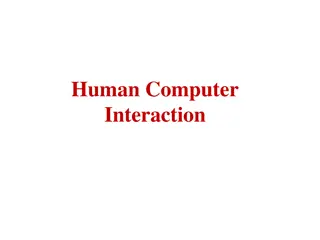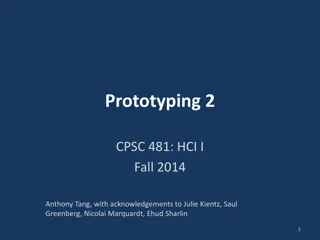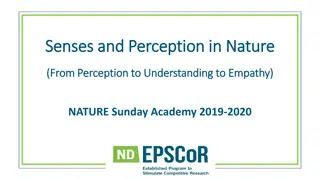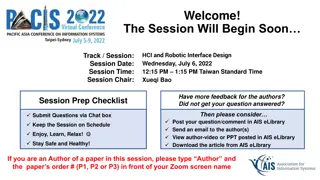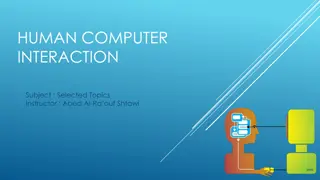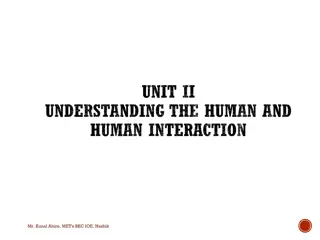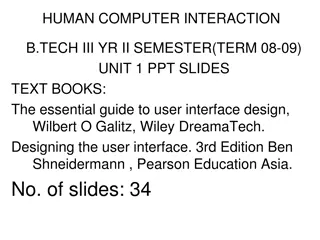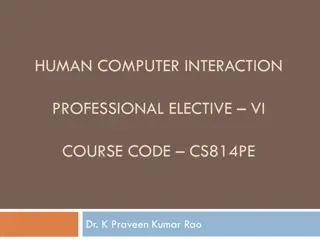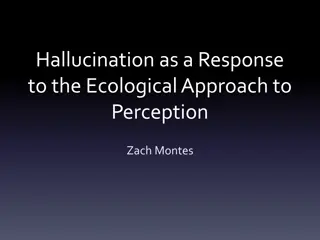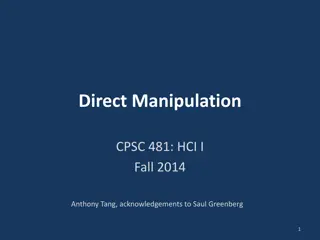Understanding Human Perception and Interaction in HCI
Human-Computer Interaction (HCI) involves the study of how humans interact with computers using various input and output channels such as vision, hearing, touch, and memory. Vision is crucial as it is the primary source of information, while hearing and touch play significant roles in conveying information. Human memory is essential for everyday activities. Enhancing user experience in HCI requires understanding and leveraging human senses effectively.
Download Presentation

Please find below an Image/Link to download the presentation.
The content on the website is provided AS IS for your information and personal use only. It may not be sold, licensed, or shared on other websites without obtaining consent from the author. Download presentation by click this link. If you encounter any issues during the download, it is possible that the publisher has removed the file from their server.
E N D
Presentation Transcript
Human Computer Interaction
Human Factor 1. Human s Input output Channels 2. Human memory 3. Thinking : Reasoning and Problem Solving
Humans Input output Channels * A person s interaction with the outside world occurs through information being received and sent: input and output. * In an interaction with a computer the user receives information that is output by the computer, and responds by providing input to the computer the user s output becomes the computer s input and vice versa. * There are five major senses; sight, hearing, touch, taste and smell. Of these, the first three are the most important to HCI. Taste and smell do not currently play a significant role in HCI.
Vision Human vision is a highly complex activity with a range of physical and perceptual limitations, yet it is the primary source of information for the average person. We can roughly divide visual perception into two stages: 1. The physical reception of the stimulus from the outside world 2. The processing and interpretation of that stimulus. Vision begins with light. The eye is a mechanism for receiving light and transforming it into electrical energy. There are several stages in the reading process. 1. First the visual pattern of the word on the page is perceived . 2. Second it is then decoded with reference to an internal representation of language. 3. Third language processing include syntactic and semantic analysis and operate on phrases or sentences.
Hearing The sense of hearing is often considered secondary to sight, but we tend to underestimate the amount of information that we receive through our ears. sound can convey a remarkable amount of information. It is rarely used to its potential in interface design, usually being confined to warning sounds and notifications. The exception is multimedia, which may include music, voice commentary and sound effects. This suggests that sound could be used more extensively in interface design, to convey information about the system state.
Touch The third and last of the senses that we will consider is touch or haptic perception. Although this sense is often viewed as less important than sight or hearing, imagine life without it. * Touch provides us with vital information about our environment. It tells us when we touch something hot or cold, and can therefore act as a warning * The apparatus of touch differs from that of sight and hearing in that it is not localized. * We receive stimuli through the skin. The skin contains three types of sensory receptor. * although the whole of the body contains such receptors, some areas have greater sensitivity or acuity than others.
Human Memory Indeed, much of our everyday activity relies on memory. as well as storing all our factual knowledge, our memory contains our knowledge of actions or procedures. It allows us to repeat actions, to use language, and to use new information received via our senses. It also gives us our sense of identity, by preserving information from our past experiences. It is generally agreed that there are three types of memory or memory function: 1. Sensory buffers 2. Short time memory (working memory) 3. Long term memory Attention rehearsal Short-term memory or working memory long-term memory Sensory memories Iconic Echoic Haptic A model of the structure of memory
1- Sensory memory The sensory memories act as buffers for stimuli received through the senses. A sensory memory exists for each sensory channel: 1.Iconic memory for visual stimuli. 2.Echoic memory for aural stimuli. 3.Haptic memory for touch. These memories are constantly overwritten by new information coming in on these channels. 2- Short -term memory Acts as a " scratch-pad" for temporary recall of information. It is used to store information which is only required fleetingly. * short term memory can be accessed rapidly, in the order of 70 ms. However, it also decays rapidly, meaning that information can only be held there temporarily * Short term memory has a limited capacity. * There are two basic methods for measuring memory capacity. 1.Length of a sequence which can be remembered in order. 2.The second allows items to be freely recalled in any order.
3- Long -term memory Is our main resource. Here we store factual information, experiential knowledge, procedural rules of behavior in fact, everything that we know . It differs from short-term memory in a number of significant ways: 1. It has a huge if not unlimited, capacity 2. It has a relatively slow access time of approximately a tenth of a second. 3. Forgetting occurs more slowly in long-term memory. Long-term memory is intended for the long-term stage of information. Information is placed there from working memory through rehearsal. Unlike working memory there is little decay: long-term recall after minutes is the same as that after hours or days. There are two types of long-term memory : 1. Episodic memory 2. Semantic memory
Thinking : Reasoning and Problem Solving This is perhaps the area which is most complex and which separates humans from other information processing system, both artificial and natural. * Although it is clear that animals receive and store information, there is little evidence to suggest that they can use it in quite the same way as humans. * Similarly, artificial intelligence has produced machines which can see and store information. But their ability to use that information is limited to small domains. Thinking can require different amounts of knowledge. Some thinking activities are very directed and the knowledge required is constrained. others require vast amount of knowledge from different domains.
Reasoning is the process by which we use the knowledge we have to draw conclusions or infer something new about the domain of interest. There are a number of different types of reasoning. We use each of these types of reasoning in everyday life, but they differ in significant way. 1. Deductive reasoning 2. Inductive reasoning 3. Abductive reasoning Problem solving If reasoning is a means of inferring new information from what is already known Problem solving is the process of finding a solution to an unfamiliar task, using the knowledge we have. Human problem solving is characterized by the ability to adapt the information we have to deal with new situation. There are a number of different views of how people solve problems: 1. Gestalt theory 2. Problem space theory 3. Analogy in problem solving
H.W 1) What are the human senses that are the most important to HCI? 2) What are the stages in the reading process? 3) What are the types of memory in humans? 4) Compare between LTM and STM? 5) How to make use of sound in the design of the user interface? 6) What are the definitions of Reasoning and Problem-Solving? How can differentiate between them?


